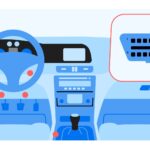The term “OBD2” often surfaces when discussing connected vehicles and fleet management. But what exactly is an OBD2 connector, and why is it so important? This comprehensive guide delves into the history, functionality, and significance of the OBD2 port in modern vehicles.
Understanding On-Board Diagnostics (OBD)
On-board diagnostics (OBD) refers to a vehicle’s self-diagnostic and reporting system. It allows technicians to access data from various subsystems, monitor performance, and diagnose necessary repairs. The system relies on Electronic Control Units (ECUs), essentially the vehicle’s computer, to generate this information. OBD uses a standardized protocol to retrieve this crucial data.
The Importance of OBD and OBD2
OBD plays a critical role in telematics and fleet management, providing valuable insights into vehicle health and driver behavior. Key benefits include:
- Predictive Maintenance: Track wear and tear patterns to identify potential issues before they escalate, facilitating proactive maintenance.
- Real-Time Diagnostics: Instantly diagnose problems, enabling swift and efficient repairs.
- Driver Behavior Monitoring: Measure driving habits, including speed, idling time, and harsh braking, promoting safer driving practices.
Locating the OBD2 Port
In most passenger vehicles, the OBD2 port is located beneath the dashboard on the driver’s side. It typically has a 16-pin configuration, though 6 or 9-pin variations exist in some older models.
OBD vs. OBD2: Key Differences
OBD2 is the second generation of on-board diagnostics, succeeding OBD (also known as OBD-I). While OBD-I systems were often externally connected, OBD2 is integrated into the vehicle’s internal network. This integration allows for more comprehensive data collection and standardized communication protocols.
The Evolution of OBD2: A Historical Overview
The journey of on-board diagnostics began in the 1960s, with contributions from organizations like the California Air Resources Board (CARB) and the Society of Automotive Engineers (SAE).
- Pre-Standardization: Initially, manufacturers developed proprietary systems, leading to a lack of uniformity in connectors, interfaces, and diagnostic codes.
- 1991: OBD-I Mandated in California: This marked the first step toward standardization, requiring basic on-board diagnostics in all vehicles sold in California.
- 1996: OBD2 Becomes the US Standard: All vehicles manufactured for sale in the United States were required to comply with the OBD2 standard. This ensured consistent diagnostic procedures and standardized trouble codes (DTCs).
- Global Adoption: European On-Board Diagnostics (EOBD), based on OBD2, became mandatory in the European Union for gasoline vehicles in 2001 and diesel vehicles in 2003. The World Wide Harmonized OBD (WWH-OBD) further expanded global standardization efforts.
Data Accessibility through OBD2
OBD2 provides access to vital vehicle information, including:
- Powertrain Data: Engine RPM, vehicle speed, fuel consumption, transmission data.
- Emissions System Data: Oxygen sensor readings, catalytic converter performance.
- Diagnostic Trouble Codes (DTCs): Standardized codes indicating specific malfunctions within the vehicle’s systems. Examples include P0201 (Injector Circuit Malfunction) or C0128 (Low Brake Fluid Circuit).
- Vehicle Identification Number (VIN)
- Calibration IDs
OBD2 and Telematics
OBD2 enables telematics devices to collect and transmit vehicle data wirelessly. This data is then analyzed to provide insights into fleet performance, driver behavior, and vehicle health. Geotab, a leading telematics provider, leverages OBD2 data to offer comprehensive fleet management solutions.
World Wide Harmonized OBD (WWH-OBD)
WWH-OBD is an international standard for vehicle diagnostics, promoting global consistency in data collection and reporting. Key advantages include:
- Expanded Data Access: WWH-OBD allows for more data points compared to traditional OBD2.
- Detailed Fault Information: Provides more comprehensive information about diagnostic trouble codes, including fault mode, severity, and status.
- Future-Proofing: Adapts and incorporates evolving diagnostic technologies, such as Unified Diagnostic Services (UDS).
Conclusion
The OBD2 connector is a critical component in modern vehicles, enabling diagnostics, repairs, and data-driven insights for fleet management. Its standardized protocol and widespread adoption have revolutionized the automotive industry, paving the way for connected car technologies and enhanced vehicle maintenance. From its humble beginnings to its global reach, the OBD2 port continues to play a vital role in the evolution of the automotive landscape.
